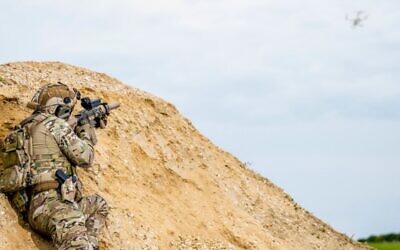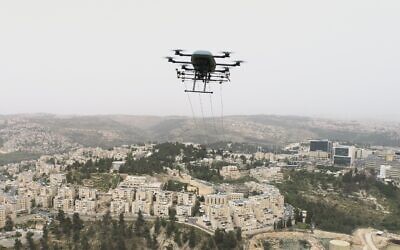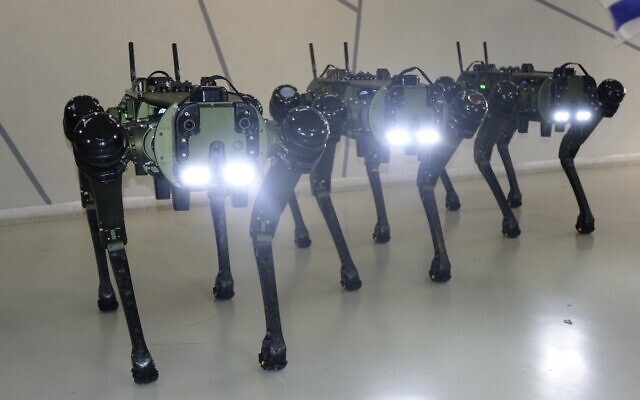Tomorrow’s battlefield: AI, robotic dogs, and drone helicopters
At an exclusive briefing at the Ministry of Defence headquarters in Tel Aviv, Jewish News gets a look at the future of warfare
Robotic dogs entering Hamas tunnels, artificial intelligence enhancing weapons accuracy and joystick-driven tanks. The sky’s the limit when it comes to Israel’s defence capabilities.
Israel has long been seen as one of the world’s leading weapons manufacturers, investing huge sums in technological know-how that brings new solutions to both defence and offence capabilities.
And with the IDF currently engaging in one of its longest wars in decades, new weapons are being used for the first time ever. At an exclusive briefing af the Ministry of Defence headquarter in Tel Aviv, Jewish News got a look in to the future of modern warfare.
Some of the weapons have been used for the first time during Israel’s war with Hamas, such as Smart Shooter’s “SMASH”
“It uses picture recognition to help you find the target. When you see it, you squeeze the trigger, but the weapon only releases the bullet once it knows you will hit the target. So in a way, every soldier today is practically a sniper,” Head of Planning, Economics and IT Department in the DDR&D (MAFAT), Col. Nir Weingold, told Jewish News.

SMASH is just one of many weapons using artificial intelligence. According to Weingold, the Israel tries to implement any of its systems with AI, from aircrafts to intelligence.
One of the ways it’s already using AI is to detect Hamas terrorists inside the Gaza Strip, using facial recognition.
The Directorate of Defense Research & Development, a joint organization of the IDF and the Ministry of Defense, is a massive enterprise in Israel. It employs 800 people, works with 17 international partners and 200 Israeli startups, and runs 1,500 projects a year.
It also works closely with the IDF, Mossad, and the Air Force, to name a few, where its role is to provide solutions to operational gaps and develop new capabilities to enter the battlefield.
The department also collaborates with Israel’s electric and water company, and runs a dual use fund with the Israel Innovation Authority.
One of the overall goals for Israel is to minimise the threat to soldiers operating in enemy territory. A lot of the new weapons and defence capabilities are therefore unmanned, such as the D9 bulldozer, which is currently used extensively by the IDF in Gaza.
The bulldozer is remotely controlled, the same way as drones, which are the eyes of the army across the Strip.
One type of drone is controlled with virtual reality glasses and joysticks and is being used to enter apartments in Gaza with a camera before soldiers enter.
The same principle is used in Hamas’ tunnels, which are often boobytrapped. IDF is currently using dogs, robotic dogs, and other means
to enter the tunnels and check for terrorists and explosive devices before the soldiers enter.
But despite the robotic dog being a clear asset for the IDF, Weingold isn’t sure they will replace dogs altogether.
A dog has his own capabilities that a robot won’t,” he says. But when it comes to aircrafts, Weingold is of a different opinion: “Our goal is to eventually use as many unmanned aircrafts as we can.”
One of the new drones currently being developed by the department shoots a net over a hostile drone when it enters heavily populated areas. That way, it minimises any damage the explosion can do to people on the ground.
Another, heavier and more sophisticated drone, is known as the “Helicopter” due to its close resemblance to an actual helicopter.
It’s one of the largest drones on the market, and can carry hundreds of kilos of weapons or other material. This drone, however, is still undergoing more tests before it can be used in the battlefield.

7-12 minutes
One of Israel’s most advanced defence capabilities is the air defence systems. They have become a vital part of the IDF’s defence, protecting millions of civilians from Eilat in the south to Rosh Pina in the north.
The Iron Dome missile system is the best known of them all, and was developed after the 2006 war between Israel and Hezbollah. Israel decided to launch a massive investment in a missile defence system, and just four years later, the Iron Dome was ready to be used on the battlefield for the first time.
Weingold calls it the “fastest development in the world” of its kind. The department’s director, Dr. Daniel Gold, is also known as the “father of the Iron Dome.”
“There is no other organisation in the world that runs the DDRND which runs all the RND efforts from the very early basic research until procurement or production,. We execute full scale development for IDF,” Weingold said.
Since Hamas’ terror attack on October 7, more than 9,000 rockets and missiles were fired from Gaza at Israel. The Iron Dome shot down most of those, with a notorious accuracy rate of over 90%. But the more advanced air defence system, David’s Sling, was used for the first time ever to help shoot down rockets from Gaza.
On Israel’s northern border, more than 2,000 projectiles were fired from Lebanon, mainly from Hezbollah.
And in Israel’s south, over 110 missiles and drones were fired by the Houthi rebels in Yemen toward Eilat, some of which were 500 kilo ballistic missiles. During those attacks, another weapons system was used for the first time in Israel’s history; the highly advanced Arrow 2 and Arrow 3 missile defence systems, used to intercept ballistic missiles in space.
Two countries in particular will have been pleased with seeing both David’s Sling and Arrow successfully shoot down rockets and missiles; Germany and Finland.
In September last year, Germany signed a £3,44 billion deal with Israel to buy its Arrow air defence system. And in November, Finland purchased the David’s Sling system from Israel for £272 million.
When asked how protected Israel is against more advanced ballistic missiles from Iran, Weingold said that the Arrow systems can shoot down the longest ranging and heaviest ones. And if Iran fires from the area in the country closest to Israel, the missile defence systems would have between 7-12 minutes to shoot down the ballistic missiles.
“We planned the system for a 99./9% success rate. The Arrow 3 gets chances, and if they miss, Arrow 2 will try. If it also fails, David’s Sling and Iron Dome will try,” he said.
The latest advanced air system to be developed is the Iron Beam high-power laser system, which can shoot down missiles and rockets using laser technology.
“The Iron Beam will be implemented in the Iron Dome. Then it will decide whether to use the laser or a missile to shoot down the threat. We believe it will be operational by the end of 2025,” Weingold said.
While the DDR&D department is pushing the boundaries of what’s possible on the battlefield, it also faces challenges: “A big challenge is the bureaucracy. It’s very time consuming. It’s our weak spot but we constantly try to improve this.”

Thank you for helping to make Jewish News the leading source of news and opinion for the UK Jewish community. Today we're asking for your invaluable help to continue putting our community first in everything we do.
For as little as £5 a month you can help sustain the vital work we do in celebrating and standing up for Jewish life in Britain.
Jewish News holds our community together and keeps us connected. Like a synagogue, it’s where people turn to feel part of something bigger. It also proudly shows the rest of Britain the vibrancy and rich culture of modern Jewish life.
You can make a quick and easy one-off or monthly contribution of £5, £10, £20 or any other sum you’re comfortable with.
100% of your donation will help us continue celebrating our community, in all its dynamic diversity...
Engaging
Being a community platform means so much more than producing a newspaper and website. One of our proudest roles is media partnering with our invaluable charities to amplify the outstanding work they do to help us all.
Celebrating
There’s no shortage of oys in the world but Jewish News takes every opportunity to celebrate the joys too, through projects like Night of Heroes, 40 Under 40 and other compelling countdowns that make the community kvell with pride.
Pioneering
In the first collaboration between media outlets from different faiths, Jewish News worked with British Muslim TV and Church Times to produce a list of young activists leading the way on interfaith understanding.
Campaigning
Royal Mail issued a stamp honouring Holocaust hero Sir Nicholas Winton after a Jewish News campaign attracted more than 100,000 backers. Jewish Newsalso produces special editions of the paper highlighting pressing issues including mental health and Holocaust remembrance.
Easy access
In an age when news is readily accessible, Jewish News provides high-quality content free online and offline, removing any financial barriers to connecting people.
Voice of our community to wider society
The Jewish News team regularly appears on TV, radio and on the pages of the national press to comment on stories about the Jewish community. Easy access to the paper on the streets of London also means Jewish News provides an invaluable window into the community for the country at large.
We hope you agree all this is worth preserving.






















